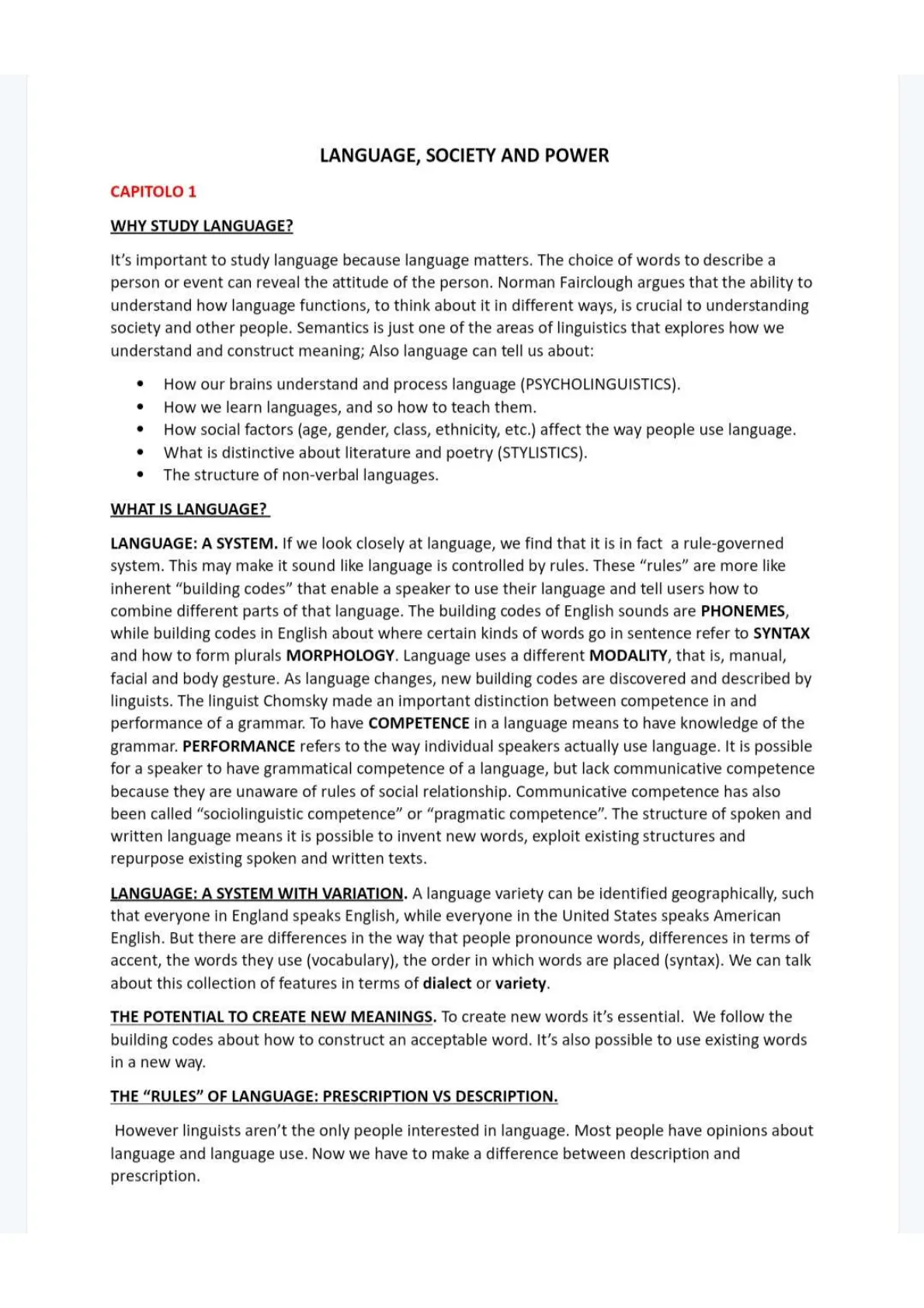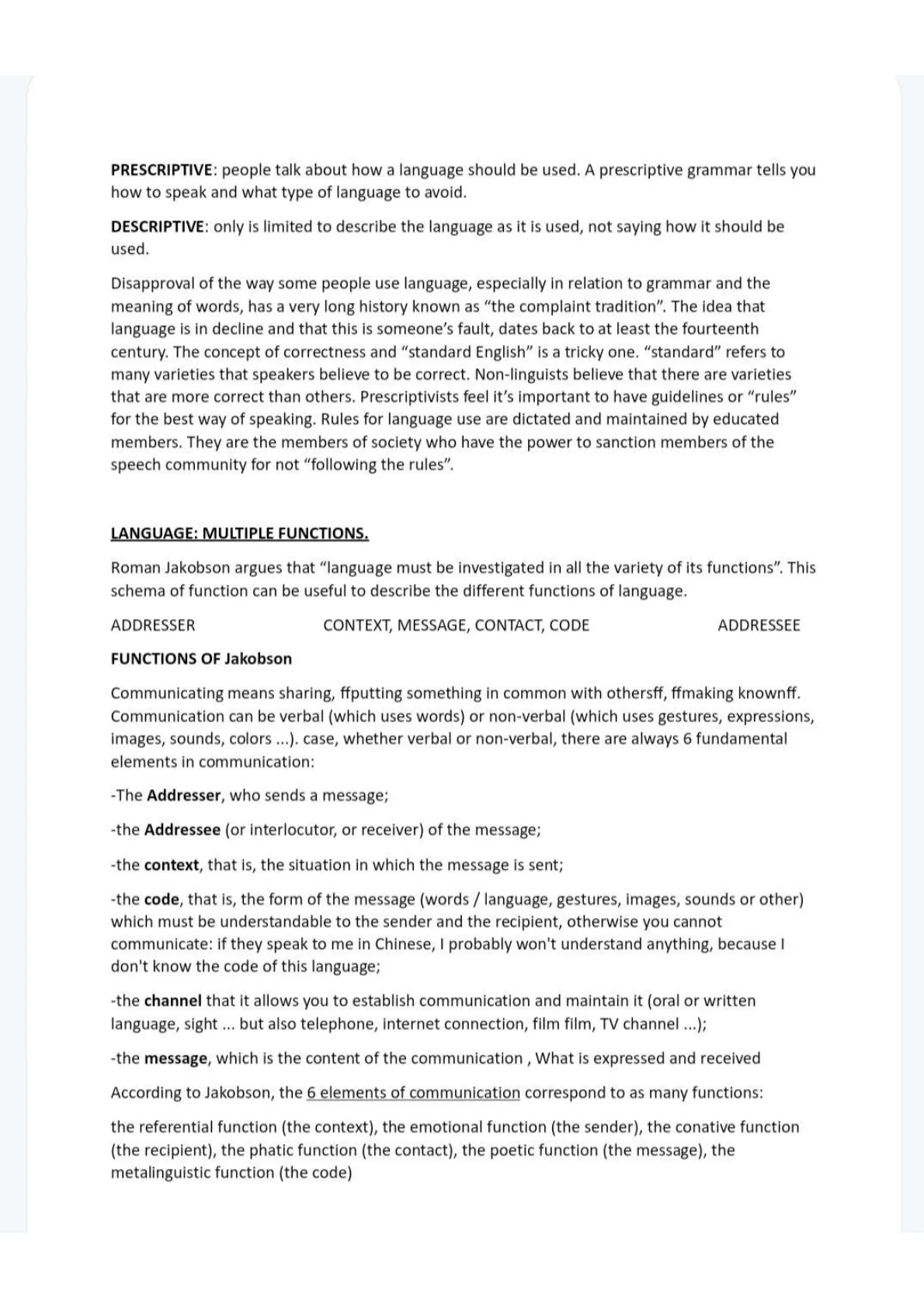Language, Society and Power: Linguistics and Media Communication
Document about Language, Society and Power. The Pdf explores the relationship between language, society, and power, analyzing linguistics and media communication. This university-level material in Languages is structured into chapters that delve into various aspects of communication and reality perception through language.
Mostra di più14 pagine


Visualizza gratis il Pdf completo
Registrati per accedere all’intero documento e trasformarlo con l’AI.
Anteprima
CAPITOLO 1
WHY STUDY LANGUAGE?
It's important to study language because language matters. The choice of words to describe a person or event can reveal the attitude of the person. Norman Fairclough argues that the ability to understand how language functions, to think about it in different ways, is crucial to understanding society and other people. Semantics is just one of the areas of linguistics that explores how we understand and construct meaning; Also language can tell us about:
- How our brains understand and process language (PSYCHOLINGUISTICS).
- How we learn languages, and so how to teach them.
- How social factors (age, gender, class, ethnicity, etc.) affect the way people use language.
- What is distinctive about literature and poetry (STYLISTICS).
The structure of non-verbal languages.
WHAT IS LANGUAGE?
LANGUAGE: A SYSTEM.
If we look closely at language, we find that it is in fact a rule-governed system. This may make it sound like language is controlled by rules. These "rules" are more like inherent "building codes" that enable a speaker to use their language and tell users how to combine different parts of that language. The building codes of English sounds are PHONEMES, while building codes in English about where certain kinds of words go in sentence refer to SYNTAX and how to form plurals MORPHOLOGY. Language uses a different MODALITY, that is, manual, facial and body gesture. As language changes, new building codes are discovered and described by linguists. The linguist Chomsky made an important distinction between competence in and performance of a grammar. To have COMPETENCE in a language means to have knowledge of the grammar. PERFORMANCE refers to the way individual speakers actually use language. It is possible for a speaker to have grammatical competence of a language, but lack communicative competence because they are unaware of rules of social relationship. Communicative competence has also been called "sociolinguistic competence" or "pragmatic competence". The structure of spoken and written language means it is possible to invent new words, exploit existing structures and repurpose existing spoken and written texts.
LANGUAGE: A SYSTEM WITH VARIATION.
A language variety can be identified geographically, such that everyone in England speaks English, while everyone in the United States speaks American English. But there are differences in the way that people pronounce words, differences in terms of accent, the words they use (vocabulary), the order in which words are placed (syntax). We can talk about this collection of features in terms of dialect or variety.
THE POTENTIAL TO CREATE NEW MEANINGS.
To create new words it's essential. We follow the building codes about how to construct an acceptable word. It's also possible to use existing words in a new way.
THE "RULES" OF LANGUAGE: PRESCRIPTION VS DESCRIPTION.
However linguists aren't the only people interested in language. Most people have opinions about language and language use. Now we have to make a difference between description and prescription.PRESCRIPTIVE: people talk about how a language should be used. A prescriptive grammar tells you how to speak and what type of language to avoid. DESCRIPTIVE: only is limited to describe the language as it is used, not saying how it should be used. Disapproval of the way some people use language, especially in relation to grammar and the meaning of words, has a very long history known as "the complaint tradition". The idea that language is in decline and that this is someone's fault, dates back to at least the fourteenth century. The concept of correctness and "standard English" is a tricky one. "standard" refers to many varieties that speakers believe to be correct. Non-linguists believe that there are varieties that are more correct than others. Prescriptivists feel it's important to have guidelines or "rules" for the best way of speaking. Rules for language use are dictated and maintained by educated members. They are the members of society who have the power to sanction members of the speech community for not "following the rules".
LANGUAGE: MULTIPLE FUNCTIONS.
Roman Jakobson argues that "language must be investigated in all the variety of its functions". This schema of function can be useful to describe the different functions of language.
ADDRESSER CONTEXT, MESSAGE, CONTACT, CODE ADDRESSEE FUNCTIONS OF Jakobson
Communicating means sharing, ffputting something in common with othersff, ffmaking knownff. Communication can be verbal (which uses words) or non-verbal (which uses gestures, expressions, images, sounds, colors ... ). case, whether verbal or non-verbal, there are always 6 fundamental elements in communication:
- The Addresser, who sends a message;
- the Addressee (or interlocutor, or receiver) of the message;
- the context, that is, the situation in which the message is sent;
- the code, that is, the form of the message (words / language, gestures, images, sounds or other) which must be understandable to the sender and the recipient, otherwise you cannot communicate: if they speak to me in Chinese, I probably won't understand anything, because I don't know the code of this language;
- the channel that it allows you to establish communication and maintain it (oral or written language, sight ... but also telephone, internet connection, film film, TV channel ... );
- the message, which is the content of the communication , What is expressed and received According to Jakobson, the 6 elements of communication correspond to as many functions: the referential function (the context), the emotional function (the sender), the conative function (the recipient), the phatic function (the contact), the poetic function (the message), the metalinguistic function (the code)
These 6 functions are almost never found on their own: in the same communication there are almost always two or three at the same time. Let's see what they are and what role they have in our everyday lives:
- The referential function is what we talk about, the topic of communication: a title on a page of the book, for example, has a referential function.
- The sender always expresses his point of view, his fffeelingff: this it is the emotional function, which is demonstrated through the type of words used, the gestures or the tone of the voice. For example, if the teacher says <Ma bravo !!! > you can immediately understand (from his tone of voice, from the look, from the expression of the face and from the gestures) if he really thinks you were good, or if, according to her, you did something wrong ...
- The conative function (from the Latin conari = to try) occurs when the sender tries to convince the recipient using particular expressions (in the case of language) or techniques (in the case of the use of images, sounds, gestures ... ). If you ask for something saying <Mommy, please .. > you trying to achieve your goal by implementing the persuasion strategies you know very well ... Advertising uses many techniques put together in a single message (slogan, image, etc.) to convince people to buy a product, using the conative function .
- The phatic function is used to introduce the message, to draw the listener's attention to the communication channel. The initials that precede the various programs are just for this, but also the phrases we use and hear every day: ffready?ff; ffGood morning!ff; ffAttention!ff; ffDo you want?ff; ffHow's it going?ff ; ffwho's here!ff etc.
- The poetic function serves to give a ffcertain effectff to the message: the poetic function is found in the choice of certain words and phrases, but also, in non-verbal communication, in the choice of images, colors, sounds ... The message can completely change according to the words, colors, sounds used! It is not only used in poetic texts, but also in speeches (of politicians, for example ... ) and is used a lot in advertising.
- The metalinguistic function is present when you ask for or receive an explanation of the communication code itself: the dictionary, the book in which the rules of grammar are explained, a demonstration of a formula of geometry ... have a metalinguistic function.
POWER
There are different ways in which power can be exercised trough language. Small variation in language can bring benefits to speakers (ex. British English speakers seen as polite). Generally, the speakers who speak the standard language gain benefits from it and so they have a degree of power but it is not the case that they as individuals are controlling others: it means that having competence in a prestigious language has benefits itself. (ex president of Turkmenistan exercising power over language). When a manager uses a particular form of language the power comes both from his position and from the kind of language used. This is called SYMBOLIC POWER.
IDEOLOGY.
In everyday contexts ideology is something negative or marked. But the ideology is simply a way of describing beliefs and behaviors that are thought as natural. In this common sense, the natural and normal way of thinking and acting is due to HEGEMONIC IDEOLOGY. Moreover ideology have another purpose: ideologies tend to present as universal interests, shared by the group as a whole as every group has its own ideology. Linguists Kress and Hodge define ideology as"systematic body of ideas, organized from a particular point of view". So we tend to talk about ideology when we want to draw attention to their power or to label another group's values. In fact power, especially symbolic power, is usually supported by ideologies.
INTERPELLATION.
As said before language has a conative function that is directed to the addressee. In that way language is linked to power as it means that language is used to place people in some way. This positioning is called by Luis Althusser interpellation. We can also be positioned by ideology, thanks to the Ideological State Apparatus (ISA) which comprises institutions that perpetuate the same ideological values of government such as the media or educational institutions. For example is common sense that, globally, the dominant mode of political organization is democracy and that of the economic structure is capitalism because they are sanctioned by education, media and governments (even if there are alternatives to these).